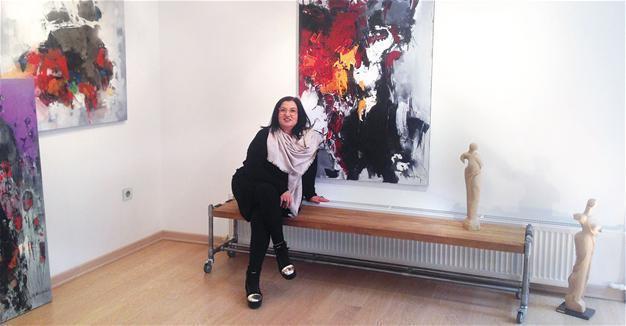A hard year for art in İzmir
Nazlan Ertan- İZMİR

From large canvases to glass figurines and musical plans, artworks recently displayed in the Aegean province of İzmir reflect the political issues of 2016, including violence against women, child abuse and environmental issues.
In Galeri A, Tülin Yiğit Akgül’s glassworks, titled “3 Rooms and 1 Living Room,” focus on women taking charge to solve their own problems.
“Rights are taken, not given. We are tired of waiting for education policies and the existing ethical norms to weigh in on the rights of women. It is time to end patience and take action. Our dreams are not limited to three rooms and a living room,” Akgül has said, referring to a young bride’s traditional/archaic dream of a perfect home.
The fragility of her glass contrasts with her message calling on women to be strong and firm in fighting for their rights. In a piece called “Vertigo,” a glass female figure wearing boxing gloves is about to punch a round glass, while in “Pride,” six female glass busts in metallic colors raise their chins in defiance.
In one of the rooms in the gallery, tens of “takunya,” (wooden clogs that women wear in hammams or bathing houses) are placed over a glass platform, their shadows reflected on the floor, against the background of a disturbing music, mixed with the murmur of female voices.
“Men have killed 236 women in the last 11 months and abused 368 girls,” Akgül said. “How many women have risen against this and stood against the violence? Or are we just trying to keep ourselves and our bodies clean and above dirt?” Then comes the punch-line of the work of the 47-year-old artist, who opened her studio “Galsst” two years ago in Galata in Istanbul: “As dead bodies are placed under our feet, whose blood do we bathe in?”
In the Noİki Art Gallery, one of the large paintings by Gina Ninkovitch displays a rectangular shape in the fire colors of red, bright orange and black. A male figure, in black with a white turban, is hiding in this burning landscape. The imagery is unmistakably the story of the Adana fire disaster, where 11 girls and an adult died in a fire that occurred in a private dormitory, reportedly run by the Süleymancılar, a religious order that has focused on religious education since the end of the 1950s.
It is unusual for Ninkovitch, an İzmir Levantine, to use such grim images in her paintings. An artist who displayed her art in the 2015 Milan Expo, she is seen by Italian critics as “the sunny, energetic voice of the Levant.” Her colors are those of the Mediterranean Sea and the energy in her paintings belongs to the buzzing multi-cultural and multi-lingual Smyrna of her youth, when her family spoke Spanish, French and Greek.
“We are the inheritors of the Roman Empire. The direction and inspiration of Turkish art is the West. I refuse to settle elsewhere. This is my home,” she said in an interview with the Hürriyet Daily News.
The other painting, more optimistic and less disturbing, is in brighter hues of pink, they are inspired by her granddaughters. “The events of last year made me very, very focused on children,” said Ninkovitch, in an indirect reference to child abuse in Turkey.
The French Cultural Center in İzmir, just a walking distance away from Noİki Art Gallery, has for the last few months been hosting a new form of art - that of talking plants. In this interactive exposition called “Akousmaflore,” digital technology is used so several potted plants can “talk” or “sing” to visitors who touch them. These living “musical” react to gentle contact by producing a specific sound.
Gregory Lasserre and Anais met den Ancxt, two artists who work together under the name Scenocosme, mix art, technology, sounds and architecture to explore invisible relationships with the environment. The expo comes to İzmir at a crucial time, when a public movement is battling with the municipality on plans to re-organize İzmir’s KültürPark, the only green space in the heart of the city. Just a stone’s throw away from the French Cultural Center, the KültürPark will be ten percent greener after renovations, but a strong public movement maintains now that international fairs are to take place in the newly-built area in Gaziemir, the park should be greener than what present plans envisage.
The art scene in İzmir has been marked with major exhibitions in 2016, like the Arkas Art Center’s “Anatolian Travels” and Folkart Gallery’s “Red,” which featured poems written by Adonis and paintings by Habip Aydoğdu, that are on their last legs this week before they close down at the end of this month.
The art scene in İzmir has also been under attack, when in May, an internationally awarded statue, “The Musician,” was vandalized by a man who said the nude statue offended public morals. Earlier this week, a 33-year-old man broke into a concert hall where pianist Fazıl Say was giving a concert, chanting “Allahu Akbar” and accused the audience of “disrespecting the mourning” of the 44 people who died in the Istanbul bombings on Dec. 10.
 From large canvases to glass figurines and musical plans, artworks recently displayed in the Aegean province of İzmir reflect the political issues of 2016, including violence against women, child abuse and environmental issues.
From large canvases to glass figurines and musical plans, artworks recently displayed in the Aegean province of İzmir reflect the political issues of 2016, including violence against women, child abuse and environmental issues.